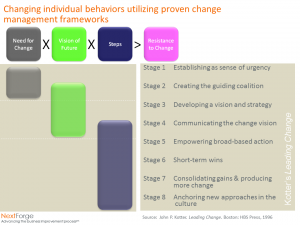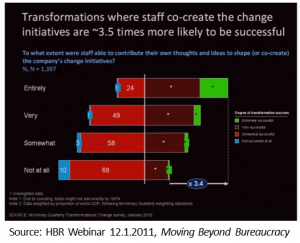 Suppose I told you there is an element of transformation which, if appropriately integrated into your plan, would increase the chances of success for your transformation effort by 350%.
Suppose I told you there is an element of transformation which, if appropriately integrated into your plan, would increase the chances of success for your transformation effort by 350%.
This is exactly what I heard during a recent webinar- a statistical validation of what I have observed and practiced my entire management consulting career.
First: context and a common problem
To help us with the context of transformation, let’s consider a just a slice of the complexity of large-scale transformation by revisiting the components of change represented in the change formula. As you may recall, the three components required to overcome the natural resistance to change include: 
- Need for change
- Vision of future
- Steps to get there
Transforming a division or company, particularly a multi-national, is very hard work. To make transformation easier, I have observed companies drifting, particularly during the first decade of this millennium, toward an over-reliance on best practices- to define the vision of the future. This focus on best practice follows an increased attention to the disciple of “process” thinking initially popularized by the reengineering programs of the early 90’s and formalized by the ERP systems necessary to ward off the Y2K issues of the late 90’s. Current use of best practices may just be the flattening of the process discipline s-curve, accelerated by 1) the explosion of advisory resources and 2) ready-access to all the industry process learnings related to the older methodologies now repurposed as best practices- a content commodity masquerading as the vision of the future.
Best practices are not enough
While best practices are not an effective operational strategy, they certainly can enable a company to the run with the pack. Best practices can also be effective if the company has fallen behind the industry norms, and/or if their competitive strategy does not rely heavily on operational practices.
Leading transformational change is more than just getting the content right. Most managers who have been through a successful major transformation understand this. From the change perspective, the successful transformation also requires a well-articulated, broadly communicated, deeply understood story- the need for change. Finally, achieving targeted business outcomes of a transformation depends on how we execute the change- the steps.
It is about involvement
The steps of how we build out the vision are centered on activity. All transformation requires people to do something, and most often to behave differently- do an activity differently- than they have for a number of years. When talking about how to change behaviors as part of transformation efforts, we advise our clients on “Change 101”- involve those who must change. This is accomplished within the context of the of the change equation’s need for change and toward the destination of the vision of the future. However, this most time-consuming effort occurs through the steps of building and executing the projects and initiatives by the employees- to achieve our business outcome- typically starting with stakeholder analysis.
 The importance of involvement, particularly in the steps, cannot be underestimated. McKinsey, the premier strategy firm, has recently conducted a bit of research summarized in June’s McKinsey Quarterly publication and further developed in a recently published text. A key finding of the research on leading change- involving employees in change initiatives increases success by approximately 3.5 times.
The importance of involvement, particularly in the steps, cannot be underestimated. McKinsey, the premier strategy firm, has recently conducted a bit of research summarized in June’s McKinsey Quarterly publication and further developed in a recently published text. A key finding of the research on leading change- involving employees in change initiatives increases success by approximately 3.5 times.
Changing individual behaviors is a foundational building block of our approach to leading change. We have observed how many companies are missing this “most critical” element of involvement, relying instead on best practices to carry the day (e.g., If you build a better mousetrap…). Involvement is required to successfully transform all levels: individual, group and organization (iGO). And, it starts with involving the individual- changing individual behavior.
“The achievements of an organization are the results of the combined effort of each individual.”
Vince Lombardi







